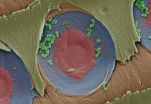(Press-News.org) A small piece of freshly cut sapwood can filter out more than 99 percent of the bacteria E. coli from water, according to a paper published in PLOS ONE on February 26, 2014 by Michael Boutilier and Jongho Lee and colleagues from MIT.
Researchers were interested in studying low-cost and easy-to-make options for filtering dirty water, a major cause of human mortality in the developing world. The sapwood of pine trees contains xylem, a porous tissue that moves sap from a tree's roots to its top through a system of vessels and pores. To investigate sapwood's water-filtering potential, researchers collected white pine branches, stripped the outer bark, and cut them into small inch-long sections. They then mounted each in plastic tubing, sealed and secured, and filtered water through that either contained small particles or E. coli bacteria.
The authors found that sapwood filtered out particles greater than 70 nanometers wide, but was unable to separate out 20-nanometer particles, suggesting that there is a particle size limit to what coniferous sapwood can filter. Sapwood also filtered out more than 99% of E. coli from water, which mostly accumulated in the first few millimeters of the wood in what are known as pit membranes. The small- branch filtration system produced water at rates up to four liters of clean drinking water a day, typically enough for one person. However, the authors caution that only hydrated sapwood (and not dried-out wood) will filter out contaminants.
"There's huge variation between plants," says Rohit Karnik, senior author on the paper. "There could be much better plants out there that are suitable for this process. Ideally, a filter would be a thin slice of wood you could use for a few days, then throw it away, and replace at almost no cost. It's orders of magnitude cheaper than the high-end membranes (currently) on the market today."
INFORMATION:
Adapted by PLOS ONE from press release by Jennifer Chu, MIT News Office
Citation: Boutilier MSH, Lee J, Chambers V, Venkatesh V, Karnik R (2014) Water Filtration Using Plant Xylem. PLoS ONE 9(2): e89934. doi:10.1371/journal.pone.0089934
Financial Disclosure: This work was supported by the James H. Ferry, Jr. Fund for Innovation in Research Education award to R.K. administered by the Massachusetts Institute of Technology. SEM imaging was performed at the Harvard Center for Nanoscale Systems, a member of the National Nanotechnology Infrastructure Network (NNIN), which is supported by the National Science Foundation under NSF award no. ECS-0335765. The funders had no role in study design, data collection and analysis, decision to publish, or preparation of the manuscript.
Competing Interest Statement: The authors have declared that no competing interests exist.
PLEASE LINK TO THE SCIENTIFIC ARTICLE IN ONLINE VERSIONS OF YOUR REPORT (URL goes live after the embargo ends):http://dx.plos.org/10.1371/journal.pone.0089934
Tree branch filters water
Pine tree sapwood filters bacteria from contaminated water
2014-02-27
ELSE PRESS RELEASES FROM THIS DATE:
Waterbirds' hunt aided by specialized tail
2014-02-27
The convergent evolution of tail shapes in diving birds may be driven by foraging style, according to a paper published in PLOS ONE on February 26, 2014 by Ryan Felice and Patrick O'Connor from Ohio University.
Birds use their wings and specialized tail to maneuver through the air while flying. It turns out that the purpose of a bird's tail may have also aided in their diversification by allowing them to use a greater variety of foraging strategies. To better understand the relationship between bird tail shape and foraging strategy, researchers examined the tail skeletal ...
MIT researchers make a water filter from the sapwood in tree branches
2014-02-27
If you've run out of drinking water during a lakeside camping trip, there's a simple solution: Break off a branch from the nearest pine tree, peel away the bark, and slowly pour lake water through the stick. The improvised filter should trap any bacteria, producing fresh, uncontaminated water.
In fact, an MIT team has discovered that this low-tech filtration system can produce up to four liters of drinking water a day — enough to quench the thirst of a typical person.
In a paper published this week in the journal PLoS ONE, the researchers demonstrate that a small ...
Study finds social-media messages grow terser during major events
2014-02-27
In the last year or two, you may have had some moments — during elections, sporting events, or weather incidents — when you found yourself sending out a flurry of messages on social media sites such as Twitter.
You are not alone, of course: Such events generate a huge volume of social-media activity. Now a new study published by researchers in MIT's Senseable City Lab shows that social-media messages grow shorter as the volume of activity rises at these particular times.
"This helps us better understand what is going on — the way we respond to things becomes faster ...
Humans have a poor memory for sound
2014-02-27
Remember that sound bite you heard on the radio this morning? The grocery items your spouse asked you to pick up? Chances are, you won't.
Researchers at the University of Iowa have found that when it comes to memory, we don't remember things we hear nearly as well as things we see or touch.
"As it turns out, there is merit to the Chinese proverb 'I hear, and I forget; I see, and I remember," says lead author of the study and UI graduate student, James Bigelow.
"We tend to think that the parts of our brain wired for memory are integrated. But our findings indicate ...
DNA test better than standard screens in identifying fetal chromosome abnormalities
2014-02-27
BOSTON (Feb. 27) – A study in this week's New England Journal of Medicine potentially has significant implications for prenatal testing for major fetal chromosome abnormalities. The study found that in a head-to-head comparison of noninvasive prenatal testing using cell free DNA (cfDNA) to standard screening methods, cfDNA testing (verifi® prenatal test, Illumina, Inc.) significantly reduced the rate of false positive results and had significantly higher positive predictive values for the detection of fetal trisomies 21 and 18.
A team of scientists, led by Diana W. Bianchi, ...
More evidence that vision test on sidelines may help diagnose concussion
2014-02-26
PHILADELPHIA – A simple vision test performed on the sidelines may help determine whether athletes have suffered a concussion, according to a study released today that will be presented at the American Academy of Neurology's 66th Annual Meeting in Philadelphia, April 26 to May 3, 2014.
The study provides more evidence that the King-Devick test, a one-minute test where athletes read single-digit numbers on index cards, can be used in addition to other tests to increase the accuracy in diagnosing concussion.
For the study, 217 members of the University of Florida men's ...
IU study ties father's age to higher rates of psychiatric, academic problems in kids
2014-02-26
BLOOMINGTON, Ind. -- An Indiana University study in collaboration with medical researchers from Karolinska Institute in Stockholm has found that advancing paternal age at childbearing can lead to higher rates of psychiatric and academic problems in offspring than previously estimated.
Examining an immense data set -- everyone born in Sweden from 1973 until 2001 -- the researchers documented a compelling association between advancing paternal age at childbearing and numerous psychiatric disorders and educational problems in their children, including autism, ADHD, bipolar ...
Improved prescribing and reimbursement practices in China
2014-02-26
Bethesda, MD — Pay-for-performance—reimbursing health care providers based on the results they achieved with their patients as a way to improve quality and efficiency—has become a major component of health reforms in the United States, the United Kingdom, and other affluent countries. Although the approach has also become popular in the developing world, there has been little evaluation of its impact. A new study, being released today as a Web First by Health Affairs, examines the effects of pay-for-performance, combined with capitation, in China's largely rural Ningxia ...
3-D microgels 'on-demand' offer new potential for cell research
2014-02-26
Stars, diamonds, circles.
Rather than your average bowl of Lucky Charms, these are three-dimensional cell cultures generated by an exciting new digital microfluidics platform, the results of which have been published in Nature Communications this week by researchers at the University of Toronto. The tool, which can be used to study cells in cost-efficient, three-dimensional microgels, may hold the key to personalized medicine applications in the future.
"We already know that the microenvironment can greatly influence cell fate," says Irwin A. Eydelnant, recent doctoral ...
New gas-phase compounds form organic particle ingredients
2014-02-26
Helsinki/Jülich/Leipzig. Scientists made an important step in order to better understand the relationships between vegetation and climate. So-called extremely low-volatility organic compounds, which are produced by plants, could be detected for the first time during field and laboratory experiments in Finland and Germany. These organic species contribute to the formation of aerosol that can affect climate and air quality, they report in this week's issue of the journal Nature. The results may help to explain discrepancies between observations and theories about how volatile ...
LAST 30 PRESS RELEASES:
On-demand upgraded recycling of polyethylene and construction of sustainable multifunctional materials based on the "LEGO" strategy
New "Stomata in-sight" system allows scientists to watch plants breathe in real-time
Anorexia nervosa may result in long-term skeletal muscle impairment
Narrative-based performance reviews deemed fairest by employees
New insights reveal how advanced oxidation can tackle emerging water pollutants
New review shows how biomass can deliver low-carbon gaseous fuels at scale
Climate change is quietly rewriting the world’s nitrogen cycle, with high stakes for food and the environment
Study finds SGLT-2 inhibitors linked to lower risk of diabetic foot nerve damage
Microbes may hold the key to brain evolution
Study examines how the last two respiratory pandemics rapidly spread through cities
Gender stereotypes reflect the division of labor between women and men across nations
Orthopedics can play critical role in identifying intimate partner violence
Worms as particle sweepers
Second spider-parasitic mite described in Brazil
January 2026 issues of APA journals feature new research on autism, pediatric anxiety, psychedelic therapy, suicide prevention and more
Private equity acquired more than 500 autism centers over the past decade, new study shows
New cervical cancer screening guidelines from the US Department of Health and Human Services
Estimated burden of COVID-19 illnesses, medical visits, hospitalizations, and deaths in the US from October 2022 to September 2024
Smartphone use during school hours by US youth
Food insecurity and adverse social conditions tied to increased risk of long COVID in children
Earliest, hottest galaxy cluster gas on record could change our cosmological models
Greenland’s Prudhoe Dome ice cap was completely gone only 7,000 years ago, first GreenDrill study finds
Scientific validity of blue zones longevity research confirmed
Injectable breast ‘implant’ offers alternative to traditional surgeries
Neuroscientists devise formulas to measure multilingualism
New prostate cancer trial seeks to reduce toxicity without sacrificing efficacy
Geometry shapes life
A CRISPR screen reveals many previously unrecognized genes required for brain development and a new neurodevelopmental disorder
Hot flush treatment has anti-breast cancer activity, study finds
Securing AI systems against growing cybersecurity threats
[Press-News.org] Tree branch filters waterPine tree sapwood filters bacteria from contaminated water



